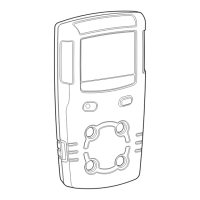GasAlertMicroClip XT
Operator’s Manual
2
• Calibrate the detector before first-time use and then
on a regular schedule, depending on use and sensor
exposure to poisons and contaminants. BW
recommends calibrating at least once every 180 days
(6 months).
• The combustible sensor is factory calibrated to 50%
LEL methane. If monitoring a different combustible
gas in the %LEL range, calibrate the sensor using
the appropriate gas.
• Only the combustible gas detection portion of this
instrument has been assessed for performance by
CSA International.
• Calibrate only in a safe area that is free of hazardous
gas and in an atmosphere of 20.9% oxygen.
• It is recommended that the combustible sensor be
checked with a known concentration of calibration
gas after any exposure to contaminants/poisons such
as, sulfur compounds, silicon vapors, halogenated
compounds, etc.
• BW recommends to bump test the sensors before each
day’s use to confirm their ability to respond to
gas by exposing the detector to a gas concentration
that exceeds the alarm setpoints. Manually verify that
the audible and visual alarms are activated. Calibrate
if the readings are not within the specified limits.
• Caution: High off-scale readings may indicate an
explosive concentration.
• Any rapid up scaling reading followed by a declining
or erratic reading may indicate a gas concentration
beyond the upper scale limit, which can be hazardous.
• Extended exposure of the GasAlertMicroClip XT to
certain concentrations of combustible gases and
air may stress a detector element that can seriously
affect its performance. If an alarm occurs due to a
high concentration of combustible gases, calibrate
the detector. If necessary, replace the sensor.
• Protect the combustible sensor from exposure to lead
compounds, silicones, and chlorinated hydrocarbons.
• Sensor exposure to certain organic vapors (such as
leaded gasoline and halogenated hydrocarbons) may
temporarily inhibit sensor performance. After exposure,
a bump test or calibration is recommended.
• For use only in potentially explosive atmospheres
where oxygen concentrations do not exceed
20.9% (v/v).

